03-AdvancedSkills
Advanced Data Engineering Skills#
Contents#
- Data Science Platform
- 81 Platform & Pipeline Design Questions
- Connect
- Buffer
- Processing Frameworks
- Lambda and Kappa Architecture
- Batch Processing
- Stream Processing
- Should You do Stream or Batch Processing
- Is ETL still relevant for Analytics?
- MapReduce
- Apache Spark
- What is the Difference to MapReduce?
- How Spark Fits to Hadoop
- Spark vs Hadoop
- Spark and Hadoop a Perfect Fit
- Spark on YARn
- My Simple Rule of Thumb
- Available Languages
- Spark Driver Executor and SparkContext
- Spark Batch vs Stream processing
- How Spark uses Data From Hadoop
- What are RDDs and How to Use Them
- SparkSQL How and Why to Use It
- What are Dataframes and How to Use Them
- Machine Learning on Spark (TensorFlow)
- MLlib
- Spark Setup
- Spark Resource Management
- AWS Lambda
- Apache Flink
- Elasticsearch
- Apache Drill
- StreamSets
- Store
- Visualize
- Machine Learning
- How to do Machine Learning in production
- Why machine learning in production is harder then you think
- Models Do Not Work Forever
- Where are The Platforms That Support Machine Learning
- Training Parameter Management
- How to Convince People That Machine Learning Works
- No Rules No Physical Models
- You Have The Data. Use It!
- Data is Stronger Than Opinions
- AWS Sagemaker
Data Science Platform#
Why a Good Data Platform Is Important#
| Podcast Episode: #066 How To Do Data Science From A Data Engineers Perspective
|------------------|
|A simple introduction how to do data science in the context of the internet of things.
| Watch on YouTube \ Listen on Anchor|
Big Data vs Data Science and Analytics#
I talked about the difference in this podcast: https://anchor.fm/andreaskayy/embed/episodes/BI-vs-Data-Science-vs-Big-Data-e199hq
The 4 Vs of Big Data#
It is a complete misconception. Volume is only one part of the often called four V's of big data: Volume, velocity, variety and veracity.
Volume is about the size - How much data you have
Velocity is about the speed - How fast data is getting to you
How much data in a specific time needs to get processed or is coming into the system. This is where the whole concept of streaming data and real-time processing comes in to play.
Variety is about the variety - How different your data is
Like CSV files, PDFs that you have and stuff in XML. That you also have JSON logfiles, or data in some kind of a key-value store.
It's about the variety of data types from different sources that you basically want to join together. All to make an analysis based on that data.
Veracity is about the credibility - How reliable your data is
The issue with big data is, that it is very unreliable.
You cannot really trust the data. Especially when you're coming from the Internet of Things (IoT) side. Devices use sensors for measurement of temperature, pressure, acceleration and so on.
You cannot always be hundred percent sure that the actual measurement is right.
When you have data that is from for instance SAP and it contains data that is created by hand you also have problems. As you know we humans are bad at inputting stuff.
Everybody articulates differently. We make mistakes, down to the spelling and that can be a very difficult issue for analytics.
I talked about the 4Vs in this podcast: https://anchor.fm/andreaskayy/embed/episodes/4-Vs-Of-Big-Data-Are-Enough-e1h2ra
Why Big Data?#
What I always emphasize is that the four V's are quite nice. They give you a general direction.
There is a much more important issue: Catastrophic Success.
What I mean by catastrophic success is, that your project, your startup or your platform has more growth that you anticipated. Exponential growth is what everybody is looking for.
Because with exponential growth there is the money. It starts small and gets very big very fast. The classic hockey stick curve:
1, 2, 4, 8, 16, 32, 64, 128, 256, 512, 1024, 2048, 4096, 8192, 16384, .... BOOM!
Think about it. It starts small and quite slow, but gets very big very fast.
You get a lot of users or customers who are paying money to use your service, the platform or whatever. If you have a system that is not equipped to scale and process the data the whole system breaks down.
That's catastrophic success. You are so successful and grow so fast that you cannot fulfill the demand anymore. And so you fail and it's all over.
It's now like you just can make that up while you go. That you can foresee in a few months or weeks the current system doesn't work anymore.
Planning is Everything#
It's all happens very very fast and you cannot react anymore. There's a necessary type of planning and analyzing the potential of your business case necessary.
Then you need to decide if you actually have big data or not.
You need to decide if you use big data tools. This means when you conceptualize the whole infrastructure it might look ridiculous to actually focus on big data tools.
But in the long run it will help you a lot. Good planning will get a lot of problems out of the way, especially if you think about streaming data and real-time analytics.
The problem with ETL#
A typical old-school platform deployment would look like the picture below. Devices use a data API to upload data that gets stored in a SQL database. An external analytics tool is querying data and uploading the results back to the SQL DB. Users then use the user interface to display data stored in the database.
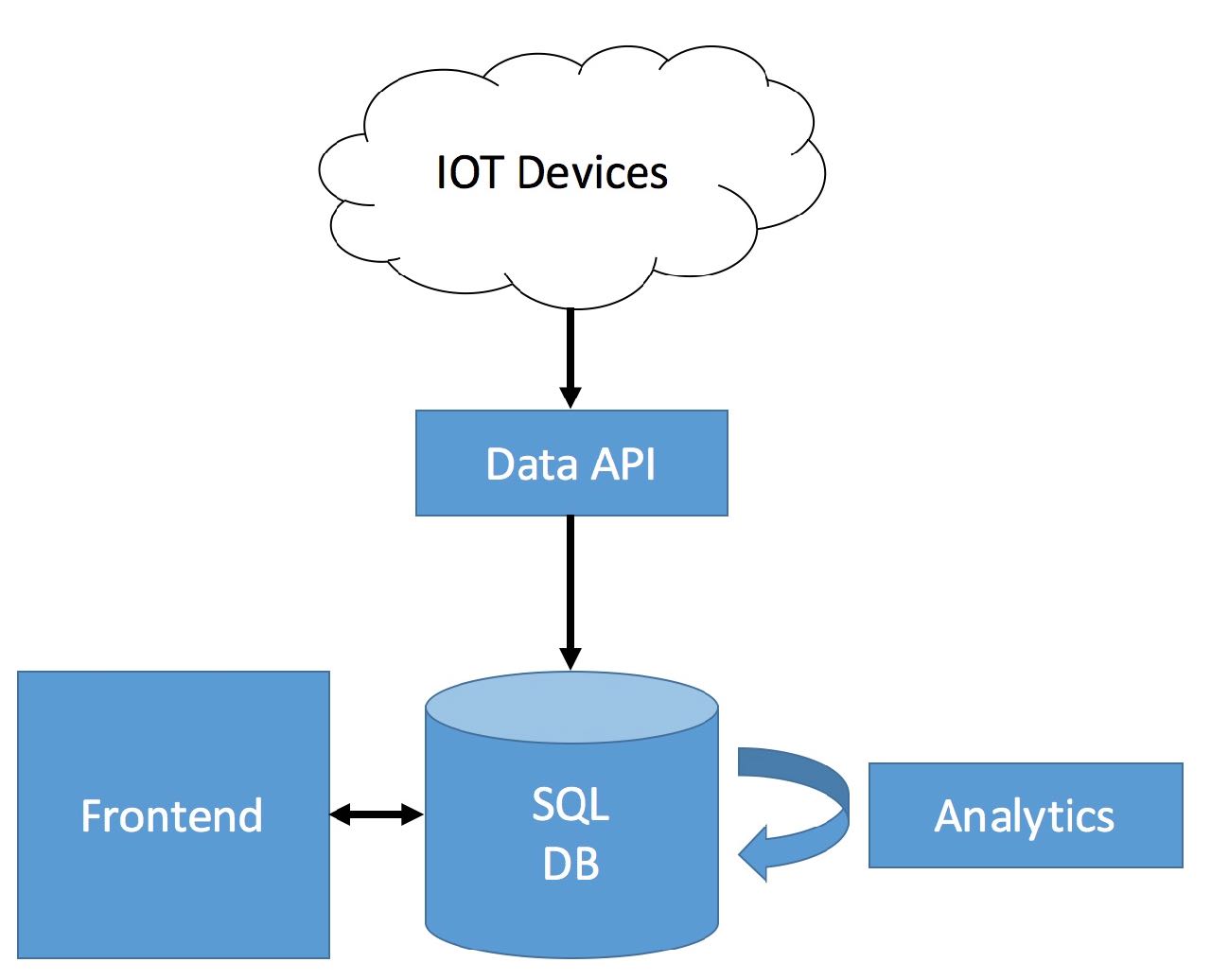
Now, when the front end queries data from the SQL database the following three steps happen:
- The database extracts all the needed rows from the storage. (E) - The extracted data gets transformed, for instance sorted by timestamp or something a lot more complex. (T) - The transformed data is loaded to the destination (the user interface) for chart creation. (L)
With exploding amounts of stored data the ETL process starts being a real problem.
Analytics is working with large data sets, for instance whole days, weeks, months or more. Data sets are very big like 100GB or Terabytes. That means Billions or Trillions of rows.
This has the result that the ETL process for large data sets takes longer and longer. Very quickly the ETL performance gets so bad it won't deliver results to analytics anymore.
A traditional solution to overcome these performance issues is trying to increase the performance of the database server. That's what's called scaling up.
Scaling Up#
To scale up the system and therefore increase ETL speeds administrators resort to more powerful hardware by:
Speeding up the extract performance by adding faster disks to physically read the data faster. Increasing RAM for row caching. What is already in memory does not have to be read by slow disk drives. Using more powerful CPU's for better transform performance (more RAM helps here as well). Increasing or optimising networking performance for faster data delivery to the front end and analytics.
In summary: Scaling up the system is fairly easy.
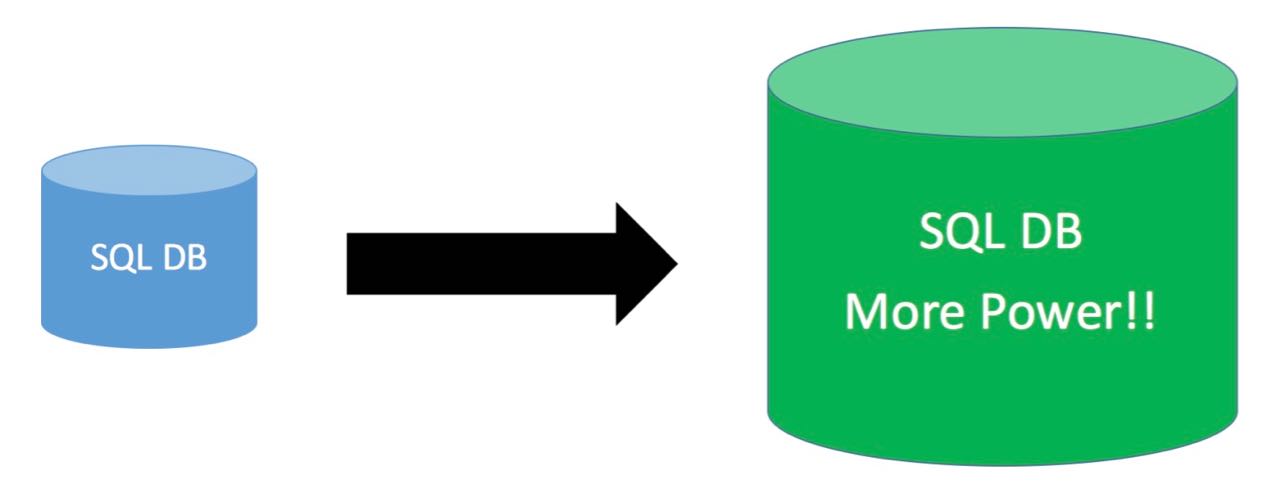
But with exponential growth it is obvious that sooner or later (more sooner than later) you will run into the same problems again. At some point you simply cannot scale up anymore because you already have a monster system, or you cannot afford to buy more expensive hardware.
The next step you could take would be scaling out.
Scaling Out#
Scaling out is the opposite of scaling up. Instead of building bigger systems the goal is to distribute the load between many smaller systems.
The easiest way of scaling out an SQL database is using a storage area network (SAN) to store the data. You can then use up to eight SQL servers (explain), attach them to the SAN and let them handle queries. This way load gets distributed between those eight servers.

One major downside of this setup is that, because the storage is shared between the SQL servers, it can only be used as an read only database. Updates have to be done periodically, for instance once a day. To do updates all SQL servers have to detach from the database. Then, one is attaching the DB in read-write mode and refreshing the data. This procedure can take a while if a lot of data needs to be uploaded.
This Link (missing) to a Microsoft MSDN page has more options of scaling out an SQL database for you.
I deliberately don't want to get into details about possible scaling out solutions. The point I am trying to make is that while it is possible to scale out SQL databases it is very complicated.
There is no perfect solution. Every option has its up- and downsides. One common major issue is the administrative effort that you need to take to implement and maintain a scaled out solution.
Please don't go Big Data#
If you don't run into scaling issues please, do not use big data tools!
Big data is an expensive thing. A Hadoop cluster for instance needs at least five servers to work properly. More is better.
Believe me this stuff costs a lot of money.
Especially when you are talking about maintenance and development on top big data tools into account.
If you don't need it it's making absolutely no sense at all!
On the other side: If you really need big data tools they will save your ass :)
81 Platform and Pipeline Design Questions#
Many people ask: "How do you select the platform, tools and design the pipelines?" The options seem infinite. Technology however should never dictate the decisions.
Here are 81 questions that you should answer when starting a project
Data Source Questions#
Data Origin and Structure#
- What is the source? Understand the "device."
- What is the format of the incoming data? (e.g., JSON, CSV, Avro, Parquet)
- What’s the schema?
- Is the data structured, semi-structured, or unstructured?
- What is the data type? Understand the content of the data.
- Is the schema well-defined, or is it dynamic?
- How are changes in the data structure from the source (schema evolution) handled?
Data Volume & Velocity#
- How much data is transmitted per transmission?
- How fast is the data coming in? (e.g., messages per minute)
- What is the maximum data volume expected per source per day?
- What scaling of sources/data is expected?
- Are there peaks for incoming data?
- How much data is posted per day across all sources?
- How does the data volume fluctuate? (e.g., seasonal peaks, hourly/daily variations)
- How will the system handle bursts of data? (e.g., throttling or buffering)
Source Reliability & Redundancy#
- Is there data arriving late?
- Is there a risk of duplicate data from the source? How will we handle de-duplication?
- How reliable are the sources? What’s the expected failure rate?
- How do we handle data corruption or loss during transmission?
- What happens if a source goes offline? Is there a fallback or failover source?
- Do we need to retry failed transmissions or have fault-tolerance mechanisms in place?
Data Extraction & New Sources#
- Do we need to extract the data from the sources?
- How many sources are there?
- Will new sources be implemented?
Data Source Connectivity & Authentication#
- How is the data arriving? (API, bucket, etc.)
- How is the authentication done?
- What kind of connection is required for the data source? (e.g., streaming, batch, API)
- What protocols are used for data ingestion? (e.g., REST, WebSocket, FTP)
- Are there any rate limits or quotas imposed by the data source?
- How do we handle credentials? Is there an API?
- What is the retry strategy if data fails to be processed or transmitted?
Data Security & Compliance#
- Does the data need to be encrypted at the source before being transmitted?
- Are there any compliance frameworks (e.g., GDPR, HIPAA) that the source data must adhere to?
- Is there a requirement for data masking or obfuscation at the source?
Metadata & Audit#
- Is there metadata for the client transmission stored somewhere?
- What metadata should be captured for each transmission? (e.g., record counts, latency)
- How do we track and log data ingestion events for audit purposes?
- Is there a need for tracking data lineage? (i.e., source origin and changes over time)
Goals and Destination Questions#
Use Case & Data Consumption#
- What kind of use case is this? (Analytics, BI, ML, Transactional processing, Visualization, User Interfaces, APIs)
- What are the typical use cases that require this data? (e.g., predictive analytics, operational dashboards)
- What are the downstream systems or platforms that will consume this data?
- How critical is real-time data versus historical data in this use case?
Data Query & Delivery#
- How is the data visualized? (raw data, aggregated data)
- How much raw data is processed at once?
- How much data is cold data, and how often is cold data queried?
- How fast do the results need to appear?
- How much data is going to be queried at once?
- How fresh does the data need to be?
- How often is the data queried? (frequency)
- What are the SLAs for delivering data to downstream systems or applications?
Aggregation & Modeling#
- How is the data aggregated? (by devices, topic, time)
- When does the aggregation happen? (on query, on schedule, while streaming)
- What kind of data models are needed for this use case? (e.g., star schema, snowflake schema)
- Is there a need for pre-aggregations to speed up queries?
- Should partitioning or indexing strategies be implemented to optimize query performance?
Performance & Availability#
- What is the processing time requirement?
- What is the availability of analytics output? (input vs output delay)
- How fresh does the data need to be?
- What are the performance expectations for query speed?
- What is the acceptable query response time for end-users?
- How will the system handle an increase in concurrent queries from multiple users?
- What is the expected lag between data ingestion and availability for querying?
- Do we need horizontal scaling for query engines or databases?
Data Lifecycle & Retention#
- What’s the data retention time?
- How often is data archived or moved to lower-cost storage?
- Will old data need to be transformed or reprocessed for new use cases?
- What are the data retention policies? (e.g., hot vs cold storage)
- How will the use case evolve as the data grows? Will this affect how data is consumed or visualized?
Monitoring & Debugging#
- How will data delivery to the destination be monitored? (e.g., time-to-load, query failures)
- How will we monitor data pipeline health at the destination? (e.g., throughput, latency)
- What tools or methods will be used for debugging data delivery failures or performance bottlenecks?
- What metrics should be tracked to ensure data pipeline health? (e.g., latency, throughput)
- How do we handle issues such as data corruption or incomplete data at the destination?
Data Access & Permissions#
- Who is working with the platform, and who has access to query or visualize the data?
- Which tools are used to query the data?
- What kind of data export capabilities are required? (e.g., CSV, API, direct database access)
- Is role-based access control (RBAC) needed to segment data views for different users?
- How will access to sensitive data be managed? (e.g., row-level security, encryption)
Scaling & Future Requirements#
- What are the scalability requirements for the data platform as data volume grows?
- How will future business goals or scalability needs affect the design of data aggregation and retention strategies?
- How will the system handle an increasing load as more users query data or as data volume grows?
Connect#
REST APIs#
APIs or Application Programming Interfaces are the cornerstones of any great data platform.
| Podcast Episode: #033 How APIs Rule The World
|------------------|
|Strong APIs make a good platform. In this episode I talk about why you need APIs and why Twitter is a great example. Especially JSON APIs are my personal favorite. Because JSON is also important in the Big Data world, for instance in log analytics. How? Check out this episode!
| Listen on Anchor|
API Design#
In this podcast episode we look into the Twitter API. It's a great example how to build an API
| Podcast Episode: #081 Twitter API Research Data Engineering Course Part 5 |------------------| |In this episode we look into the Twitter API documentation, which I love by the way. How can we get old tweets for a certain hashtags and how to get current live tweets for these hashtags? | Watch on YouTube \ Listen on Anchor|
Payload compression attacks#
How to defend your Server with zip Bombs https://www.sitepoint.com/how-to-defend-your-website-with-zip-bombs/
Implementation Frameworks#
Jersey:
https://eclipse-ee4j.github.io/jersey.github.io/documentation/latest/getting-started.html
Tutorial – REST API design and implementation in Java with Jersey and Spring: https://www.codepedia.org/ama/tutorial-rest-api-design-and-implementation-in-java-with-jersey-and-spring/
Swagger:
https://github.com/swagger-api/swagger-core/wiki/Swagger-2.X---Getting-started
Jersey vs Swagger:
https://stackoverflow.com/questions/36997865/what-is-the-difference-between-swagger-api-and-jax-rs
Spring Framework:
When to use Spring or Jersey:
OAuth security#
Apache Nifi#
Nifi is one of these tools that I identify as high potential tools. It allows you to create a data pipeline very easily.
Read data from a RestAPI and post it to Kafka? No problem Read data from Kafka and put it into a database? No problem
It's super versatile and you can do everything on the UI.
I use it in Part 3 of this Document. Check it out.
Check out the Apache Nifi FAQ website. Also look into the documentation to find all possible data sources and sinks of Nifi:
https://nifi.apache.org/faq.html
Here's a great blog about Nifi:
Logstash#
https://www.elastic.co/products/logstash
FluentD#
Data Collector
Apache Flume#
Sqoop#
Azure IoTHub#
https://azure.microsoft.com/en-us/services/iot-hub/
Buffer#
Apache Kafka#
Why a message queue tool?#
Kafka architecture#
What are topics#
What does Zookeeper have to do with Kafka#
How to produce and consume messages#
My YouTube video how to set up Kafka at home: https://youtu.be/7F9tBwTUSeY
My YouTube video how to write to Kafka: https://youtu.be/RboQBZvZCh0
KAFKA Commands#
Start Zookeeper container for Kafka:
Start Kafka container:
Redis Pub-Sub#
AWS Kinesis#
Google Cloud PubSub#
Processing Frameworks#
Lambda and Kappa Architecture#
| Podcast Episode: #077 Lambda Architecture and Kappa Architecture
|------------------|
|In this stream we talk about the lambda architecture with stream and batch processing as well as a alternative the Kappa Architecture that consists only of streaming. Also Data engineer vs data scientist and we discuss Andrew Ng’s AI Transformation Playbook.
| Watch on YouTube \ Listen on Anchor|
Batch Processing#
Ask the big questions. Remember your last yearly tax statement?
You break out the folders. You run around the house searching for the receipts.
All that fun stuff.
When you finally found everything you fill out the form and send it on its way.
Doing the tax statement is a prime example of a batch process.
Data comes in and gets stored, analytics loads the data from storage and creates an output (insight):

Batch processing is something you do either without a schedule or on a schedule (tax statement). It is used to ask the big questions and gain the insights by looking at the big picture.
To do so, batch processing jobs use large amounts of data. This data is provided by storage systems like Hadoop HDFS.
They can store lots of data (petabytes) without a problem.
Results from batch jobs are very useful, but the execution time is high. Because the amount of used data is high.
It can take minutes or sometimes hours until you get your results.
Stream Processing#
Gain instant insight into your data.
Streaming allows users to make quick decisions and take actions based on "real-time" insight. Contrary to batch processing, streaming processes data on the fly, as it comes in.
With streaming you don't have to wait minutes or hours to get results. You gain instant insight into your data.
In the batch processing pipeline, the analytics was after the data storage. It had access to all the available data.
Stream processing creates insight before the data storage. It has only access to fragments of data as it comes in.
As a result the scope of the produced insight is also limited. Because the big picture is missing.

Only with streaming analytics you are able to create advanced services for the customer. Netflix for instance incorporated stream processing into Chuckwa V2.0 and the new Keystone pipeline.
One example of advanced services through stream processing is the Netflix "Trending Now" feature. Check out the Netflix case study.
Three methods of streaming#
In stream processing sometimes it is ok to drop messages, other times it is not. Sometimes it is fine to process a message multiple times, other times that needs to be avoided like hell.
Today's topic are the different methods of streaming: At most once, at least once and exactly once.
What this means and why it is so important to keep them in mind when creating a solution. That is what you will find out in this article.
At Least Once#
At least once, means a message gets processed in the system once or multiple times. So with at least once it's not possible that a message gets into the system and is not getting processed.
It's not getting dropped or lost somewhere in the system.
One example where at least once processing can be used is when you think about a fleet management of cars. You get GPS data from cars and that data is transmitted with a timestamp and the GPS coordinates.
It's important that you get the GPS data at least once, so you know where the car is. If you're processing this data multiple times, it always has the the timestamp with it.
Because of that it does not matter that it gets processed multiple times, because of the timestamp. Or that it would be stored multiple times, because it would just override the existing one.
At Most Once#
The second streaming method is at most once. At most once means that it's okay to drop some information, to drop some messages.
But it's important that a message is only processed once as a maximum.
A example for this is event processing. Some event is happening and that event is not important enough, so it can be dropped. It doesn't have any consequences when it gets dropped.
But when that event happens it's important that it does not get processed multiple times. Then it would look as if the event happened five or six times instead of only one.
Think about engine misfires. If it happens once, no big deal. But if the system tells you it happens a lot you will think you have a problem with your engine.
Exactly Once#
Another thing is exactly once, this means it's not okay to drop data, it's not okay to lose data and it's also not okay to process data multiple times.
An example for this is banking. When you think about credit card transactions it's not okay to drop a transaction.
When dropped, your payment is not going through. It's also not okay to have a transaction processed multiple times, because then you are paying multiple times.
Check The Tools!#
All of this sounds very simple and logical. What kind of processing is done has to be a requirement for your use case.
It needs to be thought about in the design process, because not every tool is supporting all three methods. Very often you need to code your application very differently based on the streaming method.
Especially exactly once is very hard to do.
So, the tool of data processing needs to be chosen based on if you need exactly once, at least once or if you need at most once.
Should you do stream or batch processing?#
It is a good idea to start with batch processing. Batch processing is the foundation of every good big data platform.
A batch processing architecture is simple, and therefore quick to set up. Platform simplicity means, it will also be relatively cheap to run.
A batch processing platform will enable you to quickly ask the big questions. They will give you invaluable insight into your data and customers.
When the time comes and you also need to do analytics on the fly, then add a streaming pipeline to your batch processing big data platform.
Is ETL still relevant for Analytics?#
| Podcast Episode: #039 Is ETL Dead For Data Science & Big Data? |------------------| |Is ETL dead in Data Science and Big Data? In today’s podcast I share with you my views on your questions regarding ETL (extract, transform, load). Is ETL still practiced or did pre-processing & cleansing replace it. What would replace ETL in Data Engineering. | Watch on YouTube \ Listen on Anchor|
MapReduce#
Since the early days of the Hadoop eco system, the MapReduce framework is one of the main components of Hadoop alongside HDFS.
Google for instance used MapReduce to analyse stored HTML content of websites through counting all the HTML tags and all the words and combinations of them (for instance headlines). The output was then used to create the page ranking for Google Search.
That was when everybody started to optimise his website for the google search. Serious search engine optimisation was born. That was the year 2004.
How MapReduce is working is, that it processes data in two phases: The map phase and the reduce phase.
In the map phase, the framework is reading data from HDFS. Each dataset is called an input record.
Then there is the reduce phase. In the reduce phase, the actual computation is done and the results are stored. The storage target can either be a database or back HDFS or something else.
After all it's Java -- so you can implement what you like.
The magic of MapReduce is how the map and reduce phase are implemented and how both phases are working together.
The map and reduce phases are parallelised. What that means is, that you have multiple map phases (mappers) and reduce phases (reducers) that can run in parallel on your cluster machines.
Here's an example how such a map and reduce process works with data:
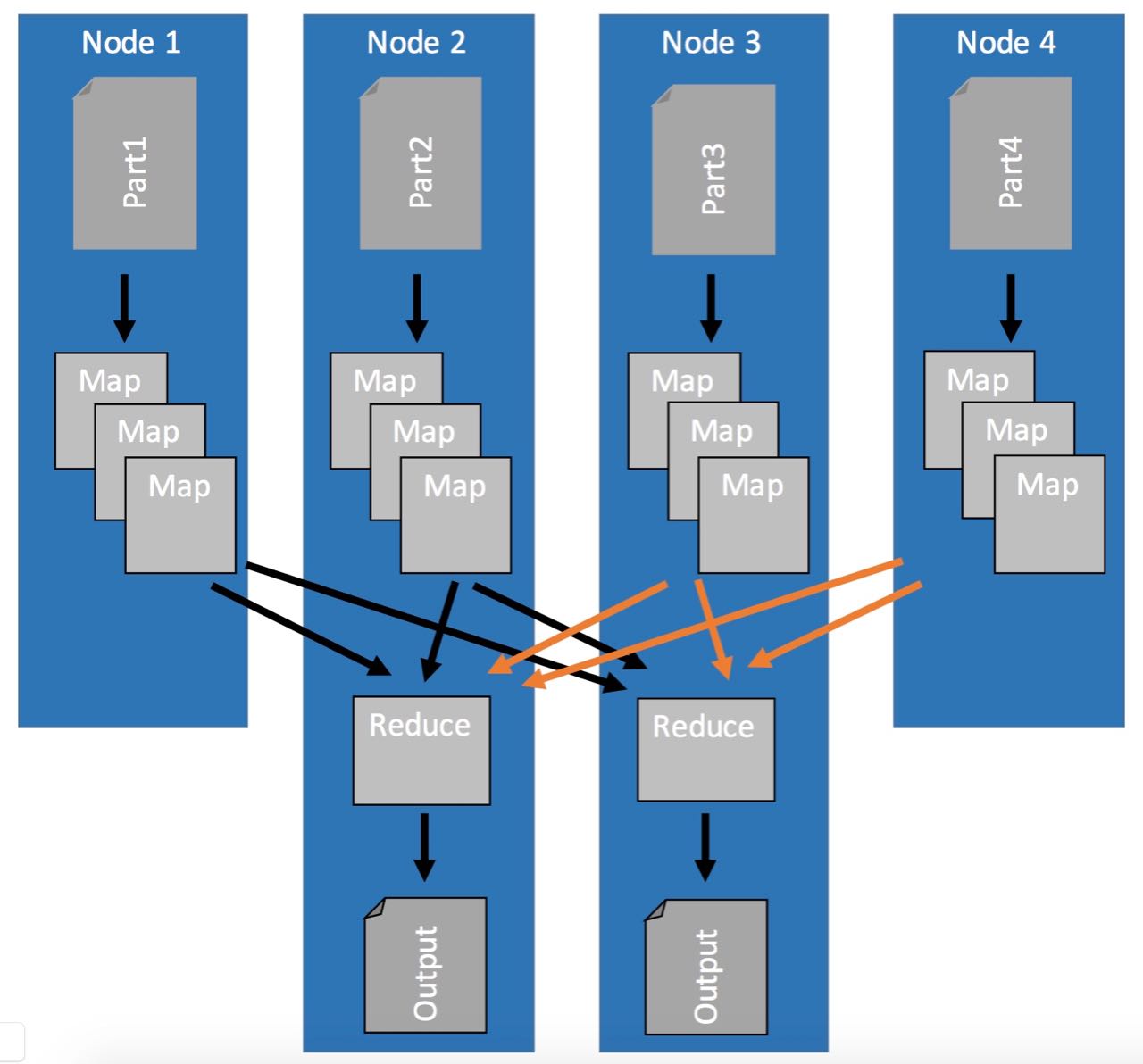
How does MapReduce work#
First of all, the whole map and reduce process relies heavily on using key-value pairs. That's what the mappers are for.
In the map phase input data, for instance a file, gets loaded and transformed into key-value pairs.
When each map phase is done it sends the created key-value pairs to the reducers where they are getting sorted by key. This means, that an input record for the reduce phase is a list of values from the mappers that all have the same key.
Then the reduce phase is doing the computation of that key and its values and outputting the results.
How many mappers and reducers can you use in parallel? The number of parallel map and reduce processes depends on how many CPU cores you have in your cluster. Every mapper and every reducer is using one core.
This means that the more CPU cores you actually have, the more mappers you can use, the faster the extraction process can be done. The more reducers you are using the faster the actual computation is being done.
To make this more clear, I have prepared an example:
Example#
As I said before, MapReduce works in two stages, map and reduce. Often these stages are explained with a word count task.
Personally, I hate this example because counting stuff is to trivial and does not really show you what you can do with MapReduce. Therefore, we are going to use a more real world use-case from the IoT world.
IoT applications create an enormous amount of data that has to be processed. This data is generated by physical sensors who take measurements, like room temperature at 8 o'clock.
Every measurement consists of a key (the timestamp when the measurement has been taken) and a value (the actual value measured by the sensor).
Because you usually have more than one sensor on your machine, or connected to your system, the key has to be a compound key. Compound keys contain in addition to the measurement time information about the source of the signal.
But, let's forget about compound keys for now. Today we have only one sensor. Each measurement outputs key-value pairs like: Timestamp-Value.
The goal of this exercise is to create average daily values of that sensor's data.
The image below shows how the map and reduce process works.
First, the map stage loads unsorted data (input records) from the source (e.g. HDFS) by key and value (key:2016-05-01 01:02:03, value:1).
Then, because the goal is to get daily averages, the hour:minute:second information is cut from the timestamp.
That is all that happens in the map phase, nothing more.
After all parallel map phases are done, each key-value pair gets sent to the one reducer who is handling all the values for this particular key.
Every reducer input record then has a list of values and you can calculate (1+5+9)/3, (2+6+7)/3 and (3+4+8)/3. That's all.
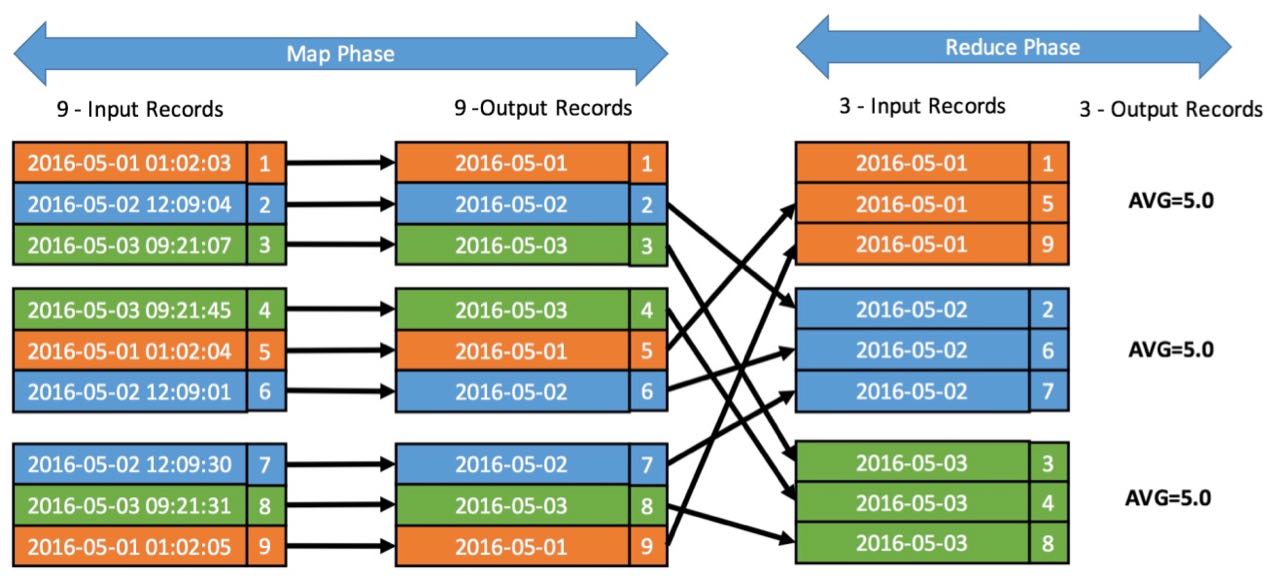
What do you think you need to do to generate minute averages?
Yes, you need to cut the key differently. You then would need to cut it like this: "2016-05-01 01:02", keeping the hour and minute information in the key.
What you can also see is, why map reduce is so great for doing parallel work. In this case, the map stage could be done by nine mappers in parallel because each map is independent from all the others.
The reduce stage could still be done by three tasks in parallel. One for orange, one for blue and one for green.
That means, if your dataset would be 10 times as big and you'd have 10 times the machines, the time to do the calculation would be the same.
What is the limitation of MapReduce?#
MapReduce is awesome for simpler analytics tasks, like counting stuff. It just has one flaw: It has only two stages Map and Reduce.

First MapReduce loads the data from HDFS into the mapping function. There you prepare the input data for the processing in the reducer. After the reduce is finished the results get written to the data store.
The problem with MapReduce is that there is no simple way to chain multiple map and reduce processes together. At the end of each reduce process the data must be stored somewhere.
This fact makes it very hard to do complicated analytics processes. You would need to chain MapReduce jobs together.
Chaining jobs with storing and loading intermediate results just makes no sense.
Another issue with MapReduce is that it is not capable of streaming analytics. Jobs take some time to spin up, do the analytics and shut down. Basically Minutes of wait time are totally normal.
This is a big negative point in a more and more real time data processing world.
Apache Spark#
I talked about the three methods of data streaming in this podcast: https://anchor.fm/andreaskayy/embed/episodes/Three-Methods-of-Streaming-Data-e15r6o
What is the difference to MapReduce?#
Spark is a complete in-memory framework. Data gets loaded from, for instance HDFS, into the memory of workers.
There is no longer a fixed map and reduce stage. Your code can be as complex as you want.
Once in memory, the input data and the intermediate results stay in memory (until the job finishes). They do not get written to a drive like with MapReduce.
This makes Spark the optimal choice for doing complex analytics. It allows you for instance to do iterative processes. Modifying a dataset multiple times in order to create an output is totally easy.
Streaming analytics capability is also what makes Spark so great. Spark has natively the option to schedule a job to run every X seconds or X milliseconds.
As a result, Spark can deliver you results from streaming data in "real time".
How does Spark fit to Hadoop?#
There are some very misleading articles out there titled \"Spark or Hadoop\", \"Spark is better than Hadoop\" or even \"Spark is replacing Hadoop\".
So, it's time to show you the differences between Spark and Hadoop. After this you will know when and for what you should use Spark and Hadoop.
You'll also understand why \"Hadoop or Spark\" is the totally wrong question.
Where's the difference?#
To make it clear how Hadoop differs from Spark I created this simple feature table:

Hadoop is used to store data in the Hadoop Distributed File System (HDFS). It can analyse the stored data with MapReduce and manage resources with YARN.
However, Hadoop is more than just storage, analytics and resource management. There's a whole eco system of tools around the Hadoop core. I've written about its eco system in this article: missing What is Hadoop and why is it so freakishly popular. You should check it out as well.
Compared to Hadoop, Spark is "just" an analytics framework. It has no storage capability. Although it has a standalone resource management, you usually don't use that feature.
Spark and Hadoop is a perfect fit#
So, if Hadoop and Spark are not the same things, can they work together?
Absolutely! Here's how the first picture will look if you combine Hadoop with Spark:
missing
As Storage you use HDFS. Analytics is done with Apache Spark and YARN is taking care of the resource management.
Why does that work so well together?
From a platform architecture perspective, Hadoop and Spark are usually managed on the same cluster. This means on each server where a HDFS data node is running, a Spark worker thread runs as well.
In distributed processing, network transfer between machines is a large bottle neck. Transferring data within a machine reduces this traffic significantly.
Spark is able to determine on which data node the needed data is stored. This allows a direct load of the data from the local storage into the memory of the machine.
This reduces network traffic a lot.
Spark on YARN:#
You need to make sure that your physical resources are distributed perfectly between the services. This is especially the case when you run Spark workers with other Hadoop services on the same machine.
It just would not make sense to have two resource managers managing the same server's resources. Sooner or later they will get in each others way.
That's why the Spark standalone resource manager is seldom used.
So, the question is not Spark or Hadoop. The question has to be: Should you use Spark or MapReduce alongside Hadoop's HDFS and YARN.
My simple rule of thumb:#
If you are doing simple batch jobs like counting values or doing calculating averages: Go with MapReduce.
If you need more complex analytics like machine learning or fast stream processing: Go with Apache Spark.
Available Languages#
Spark jobs can be programmed in a variety of languages. That makes creating analytic processes very user-friendly for data scientists.
Spark supports Python, Scala and Java. With the help of SparkR you can even connect your R program to a Spark cluster.
If you are a data scientist who is very familiar with Python just use Python, its great. If you know how to code Java I suggest you start using Scala.
Spark jobs are easier to code in Scala than in Java. In Scala you can use anonymous functions to do processing.
This results in less overhead, it is a much cleaner, simpler code.
With Java 8 simplified function calls were introduced with lambda expressions. Still, a lot of people, including me prefer Scala over Java.
How Spark works: Driver, Executor, Sparkcontext#
| Podcast Episode: #100 Apache Spark Week Day 1 |------------------| |Is ETL dead in Data Science and Big Data? In today’s podcast I share with you my views on your questions regarding ETL (extract, transform, load). Is ETL still practiced or did pre-processing & cleansing replace it. What would replace ETL in Data Engineering. | Watch on YouTube
Spark batch vs stream processing#
How does Spark use data from Hadoop#
Another thing is data locality. I always make the point, that processing data locally where it is stored is the most efficient thing to do.
That's exactly what Spark is doing. You can and should run Spark workers directly on the data nodes of your Hadoop cluster.
Spark can then natively identify on what data node the needed data is stored. This enables Spark to use the worker running on the machine where the data is stored to load the data into the memory.
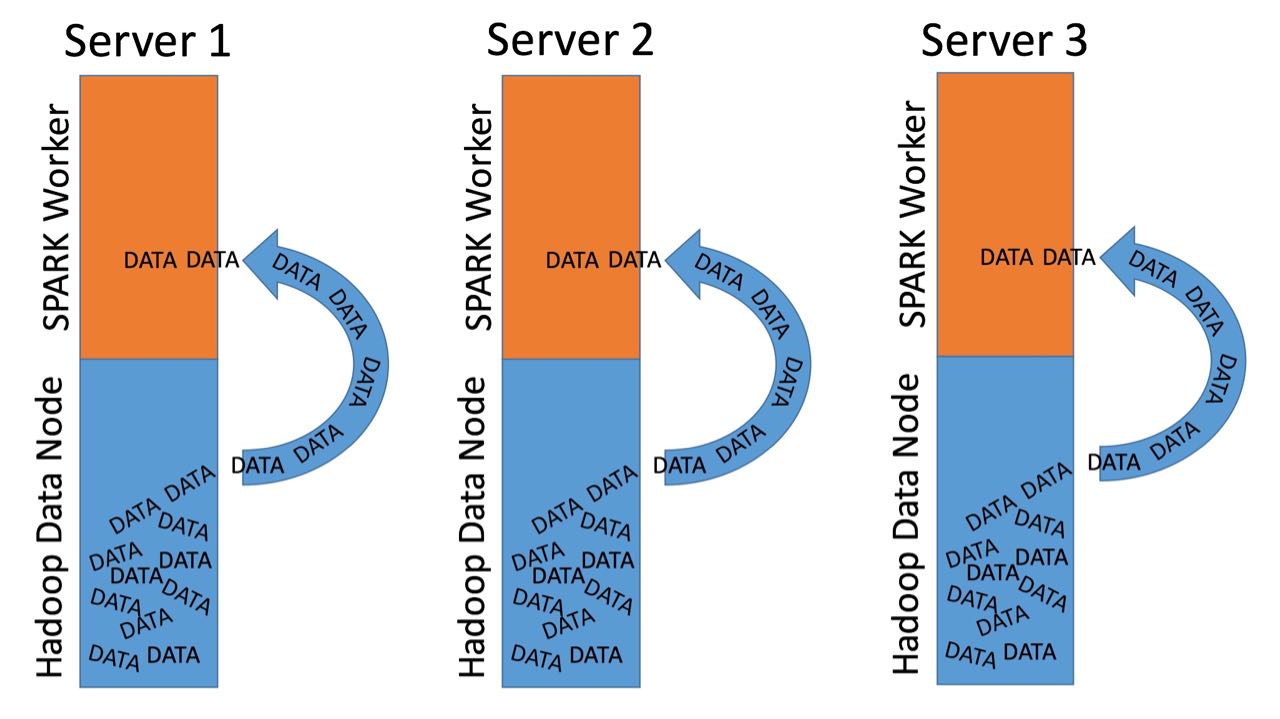
The downside of this setup is that you need more expensive servers. Because Spark processing needs stronger servers with more RAM and CPUs than a "pure" Hadoop setup.
What are RDDs and how to use them#
RDDs are the core part of Spark. I learned and used RDDs first. It felt familiar coming from MapReduce. Nowadays you use Dataframes or Datasets.
I still find it valuable to learn how RDDs and therefore Spark works at a lower level.
| Podcast Episode: #101 Apache Spark Week Day 2 |------------------| |On day two of the Apache Spark week we take a look at major Apache Spark concepts: RDDs, transformations and actions, caching and broadcast variables. | Watch on YouTube
How and why to use SparkSQL?#
When you use Apache Zeppelin notebooks to learn Spark you automatically come across SparkSQL. SparkSQL allows you to access Dataframes with SQL like queries.
Especially when you work with notebooks it is very handy to create charts from your data. You can learn from mistakes easier than just deploying Spark applications.
| Podcast Episode: #102 Apache Spark Week Day 3 |------------------| | We continue the Spark week, hands on. We do a full example from reading a csv, doing maps and flatmaps, to writing to disk. We also use SparkSQL to visualize the data. | Watch on YouTube
What are DataFrames how to use them#
As I said before. Dataframes are the successors to RDDs. It's the new Spark API.
Dataframes are basically lake Tables in a SQL Database or like an Excel sheet. This makes them very simple to use and manipulate with SparkSQL. I highly recommend to go this route.
Processing with Dataframes is even faster then with RDDs, because it uses optimization alogrithms for the data processing.
| Podcast Episode: #103 Apache Spark Week Day 4 |------------------| |We look into Dataframes, Dataframes and Dataframes. | Watch on YouTube
Machine Learning on Spark? (Tensor Flow)#
Wouldn't it be great to use your deep learning TensorFlow applications on Spark? Yes, it is already possible. Check out these Links:
Why do people integrate Spark with TensorFlow even if there is a distributed TensorFlow framework? https://www.quora.com/Why-do-people-integrate-Spark-with-TensorFlow-even-if-there-is-a-distributed-TensorFlow-framework
TensorFlow On Spark: Scalable TensorFlow Learning on Spark Clusters: https://databricks.com/session/tensorflow-on-spark-scalable-tensorflow-learning-on-spark-clusters
Deep Learning with Apache Spark and TensorFlow: https://databricks.com/blog/2016/01/25/deep-learning-with-apache-spark-and-tensorflow.html
MLlib:#
The machine learning library MLlib is included in Spark so there is often no need to import another library.
I have to admit because I am not a data scientist I am not an expert in machine learning.
From what I have seen and read though the machine learning framework MLlib is a nice treat for data scientists wanting to train and apply models with Spark.
Spark Setup#
From a solution architect's point of view Spark is a perfect fit for Hadoop big data platforms. This has a lot to do with cluster deployment and management.
Companies like Cloudera, MapR or Hortonworks include Spark into their Hadoop distributions. Because of that, Spark can be deployed and managed with the clusters Hadoop management web fronted.
This makes the process for deploying and configuring a Spark cluster very quick and admin friendly.
Spark Resource Management#
When running a computing framework you need resources to do computation: CPU time, RAM, I/O and so on. Out of the box Spark can manage resources with it's stand-alone resource manager.
If Spark is running in an Hadoop environment you don't have to use Spark's own stand-alone resource manager. You can configure Spark to use Hadoop's YARN resource management.
Why would you do that? It allows YARN to efficiently allocate resources to your Hadoop and Spark processes.
Having a single resource manager instead of two independent ones makes it a lot easier to configure the resource management.
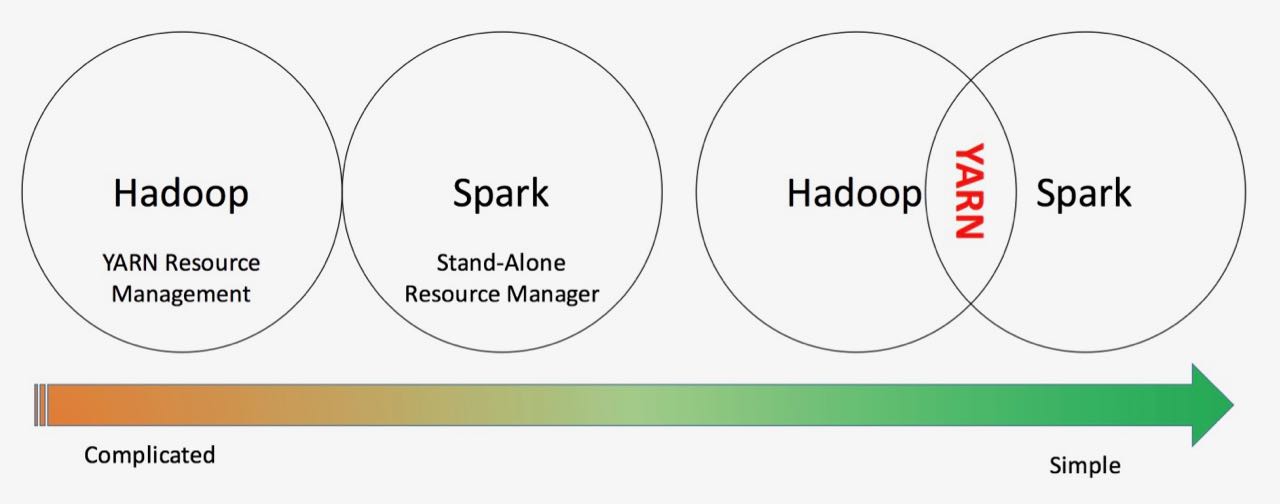
Samza#
AWS Lambda#
Apache Flink#
Elasticsearch#
Link to Elatsicsearch Homepage
Graph DB#
Graph databases store data in terms of nodes and relationships. Each node represents an entity (people, movies, things and other data points) and a relationship represents how the nodes are related. They are designed to store and treat the relationships with the same importance of that of the data (or nodes in this case). This relationship-first approach makes a lot of difference as the relationship between data need not be inferred anymore with foreign and primary keys.
Graph databases are especially useful when applications require navigating through multiple and multi-level relationships between various data points.
Neo4j#
Neo4j is currently the most popular graph database management system. It is ACID compliant and provides its own implementation of a graph database. In addition to nodes and relationships, neo4j has the following components to enrich the data model with information.
• Labels. These are used to group nodes, and each node can be assigned multiple labels. Labels are indexed to speed up finding nodes in a graph. • Properties. These are attributes of both nodes and relationships. Neo4j allows for storing data as key-value pairs, which means properties can have any value (string, number, or boolean).
Advantages#
• Neo4j is schema-free • Highly available and provides transactional guarantees • Cypher is a declarative query language which makes it very easy to navigate the graph • Neo4j is fast and easily traversible because the data is connected and is very easy to query, retrieve and navigate the graph • For the same reason as above, there are no joins in Neo4j
Disadvantages#
• Neo4j is not the best for any kind of aggregations or sorting, in comparison with a relational database • While doable, they are not the best to handle transactional data like accounting • Sharding is currently not supported
Use Cases#
Apache Solr#
Apache Drill#
Apache Storm#
StreamSets#
https://www.youtube.com/watch?v=Qm5e574WoCU&t=2s
https://streamsets.com/blog/streaming-data-twitter-analysis-spark/
Store#
Analytical Data Stores#
Data Warehouse vs Data Lake#
| Podcast Episode: #055 Data Warehouse vs Data Lake |------------------| |On this podcast we are going to talk about data warehouses and data lakes? When do people use which? What are the pros and cons of both? Architecture examples for both Does it make sense to completely move to a data lake? | Watch on YouTube \ Listen on Anchor|
Snowflake and dbt#
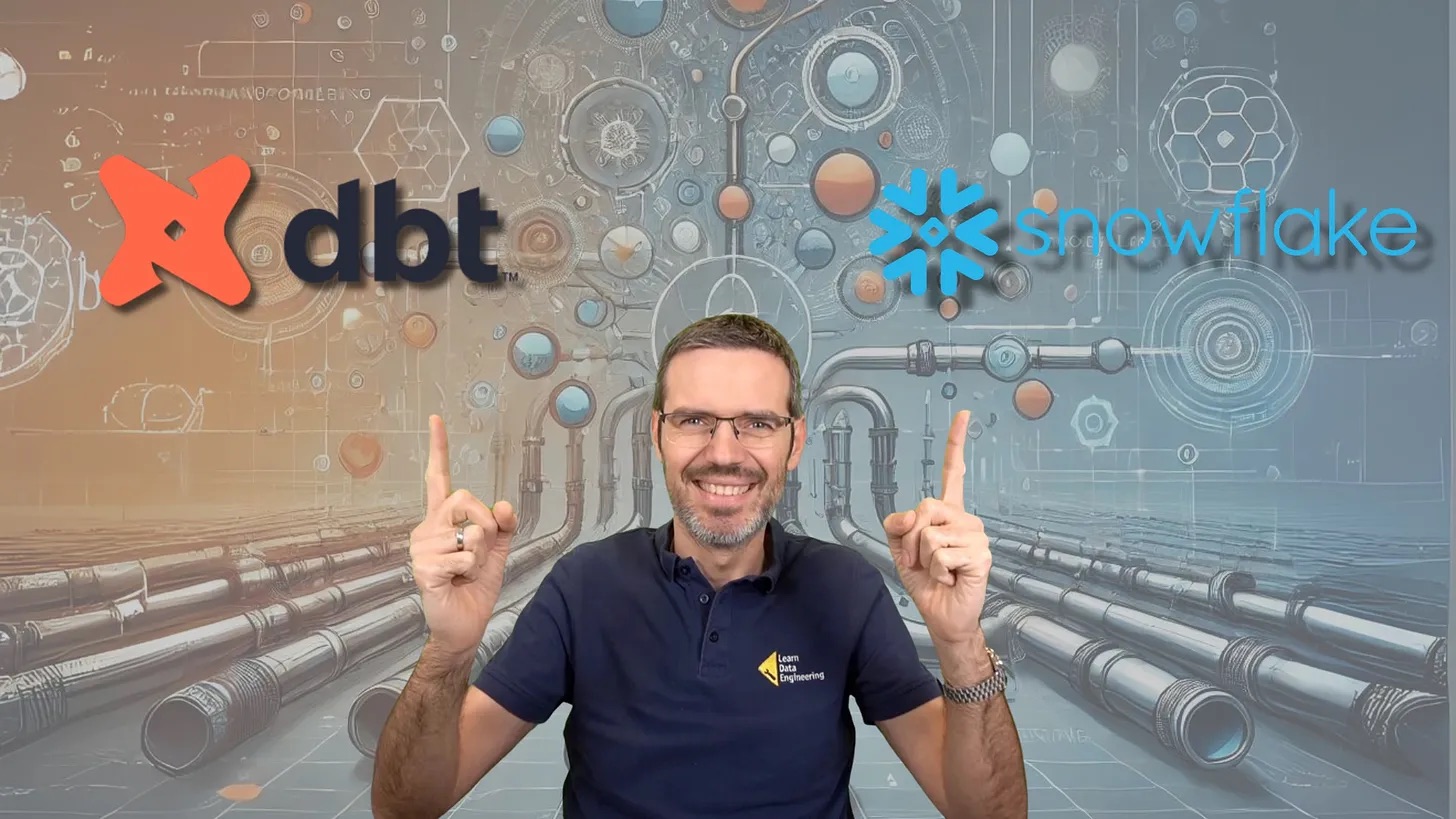
In the rapidly evolving landscape of data engineering, staying ahead means continuously expanding your skill set with the latest tools and technologies. Among the myriad of options available, dbt (data build tool) and Snowflake have emerged as indispensable for modern data engineering workflows. Understanding and leveraging these tools can significantly enhance your ability to manage and transform data, making you a more effective and valuable data engineer. Let's dive into why dbt and Snowflake should be at the top of your learning list and explore how the "dbt for Data Engineers" and "Snowflake for Data Engineers" courses from the Learn Data Engineering Academy can help you achieve mastery in these tools.
The Power of Snowflake in Data Engineering#
Snowflake has revolutionized the data warehousing space with its cloud-native architecture. It offers a scalable, flexible, and highly performant platform that simplifies data management and analytics. Here’s why Snowflake is a critical skill for data engineers:
- Cloud-Native Flexibility: Snowflake’s architecture allows you to scale resources up or down based on your needs, ensuring optimal performance and cost-efficiency.
- Unified Data Platform: It unifies data silos, enabling seamless data sharing and collaboration across the organization.
- Integration Capabilities: Snowflake integrates with various data tools and platforms, enhancing its versatility in different data workflows.
- Advanced Analytics: With its robust support for data querying, transformation, and integration, Snowflake is ideal for complex analytical workloads.
The "Snowflake for Data Engineers" course in my Learn Data Engineering Academy provides comprehensive training on Snowflake. From the basics of setting up your Snowflake environment to advanced data automation with Snowpipes, the course equips you with practical skills to leverage Snowflake effectively in your data projects.
Learn more about the course here.
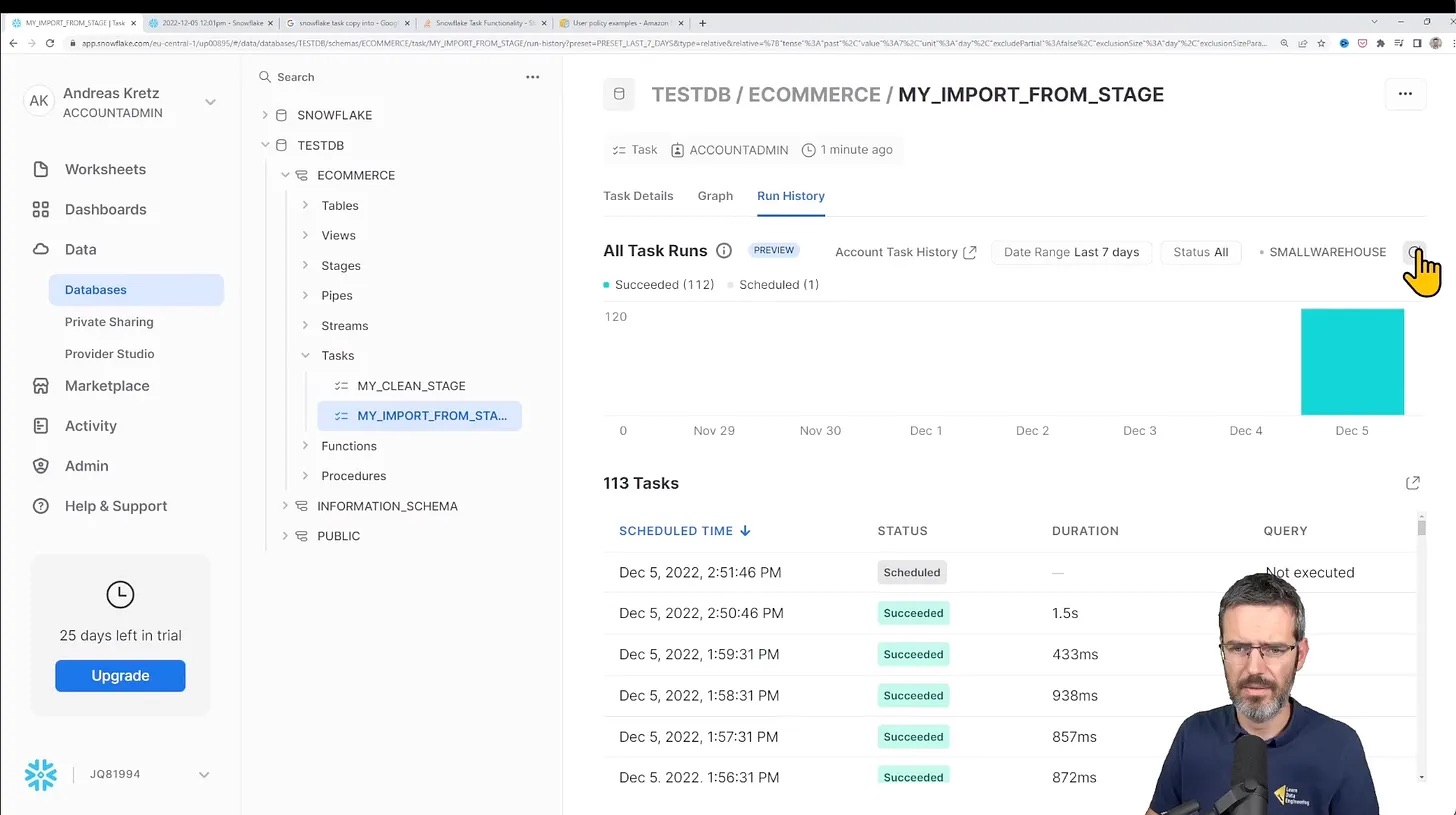
Why dbt is a Game-Changer for Data Engineers#
dbt is a powerful transformation tool that allows data engineers to transform, test, and document data directly within their data warehouse using simple SQL. Unlike traditional ETL tools, dbt operates on the principle of ELT (Extract, Load, Transform), which aligns perfectly with modern cloud data warehousing paradigms. Here are a few reasons why dbt is a must-have skill for data engineers:
- SQL-First Approach: dbt allows you to write transformations in SQL, the lingua franca of data manipulation, making it accessible to a broad range of data professionals.
- Collaboration: Teams can collaborate seamlessly, creating trusted datasets for reporting, machine learning, and operational workflows.
- Ease of Use: With dbt, you can transform, test, and document your data with ease, streamlining the data pipeline process.
- Integration: dbt integrates effortlessly with your existing data warehouse, such as Snowflake, making it a versatile addition to your toolkit.
In my Learn Data Engineering Academy you find the perfect starting point for mastering dbt with the course "dbt for Data Engineers". The course covers everything from the basics of ELT processes to advanced features like continuous integration and deployment (CI/CD) pipelines. With hands-on training, you'll learn to create data pipelines, configure dbt materializations, test dbt models, and much more.
Learn more about the course here.
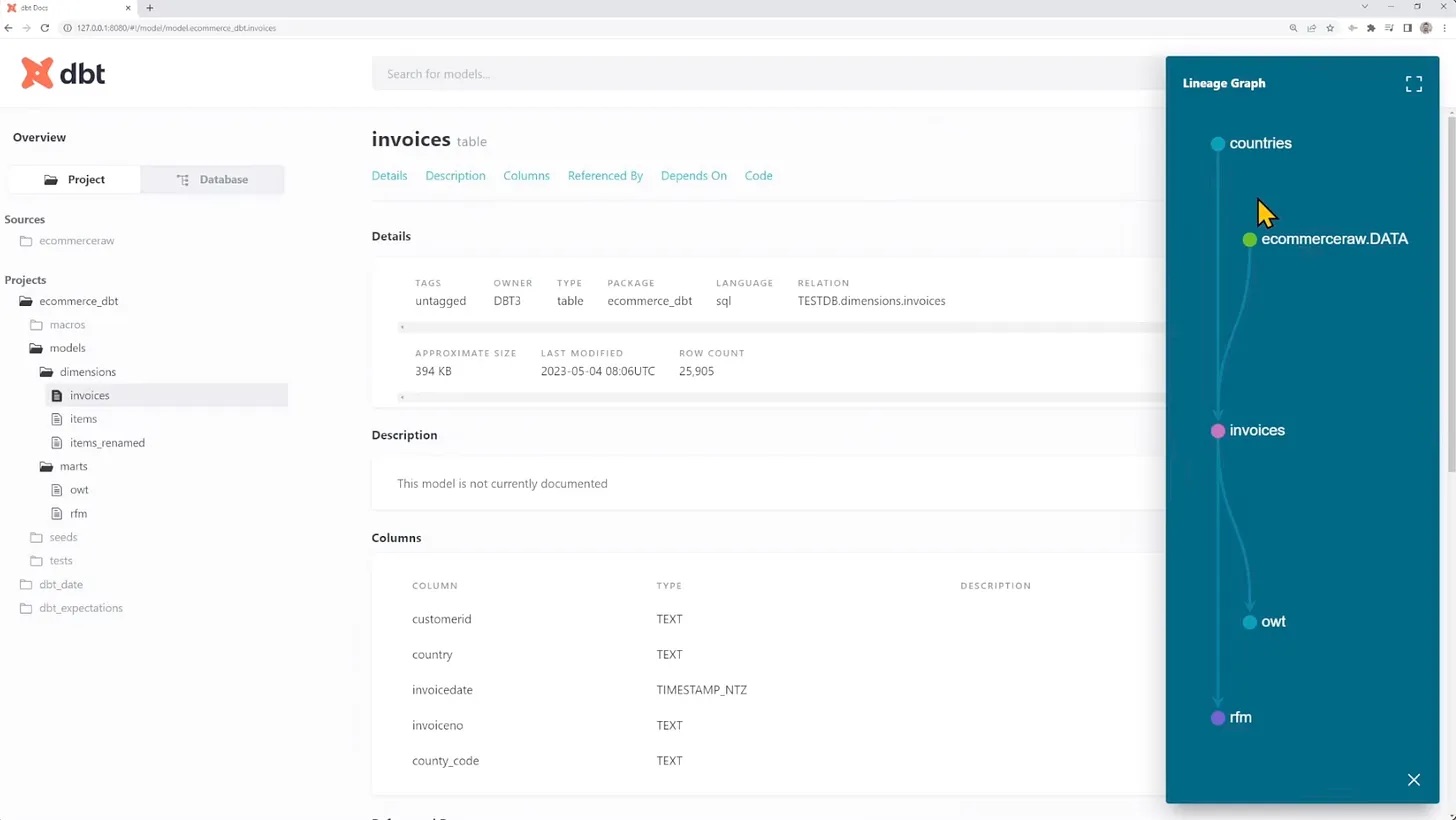
dbt and Snowflake: A Winning Combination#
When used together, dbt and Snowflake offer a powerful combination for data engineering. Here’s why:
- Seamless Integration: dbt’s SQL-first transformation capabilities integrate perfectly with Snowflake’s scalable data warehousing, creating a streamlined ELT workflow.
- Efficiency: Together, they enhance the efficiency of data transformation and analytics, reducing the time and effort required to prepare data for analysis.
- Scalability: The combined power of dbt’s model management and Snowflake’s dynamic scaling ensures that your data pipelines can handle large and complex datasets with ease.
- Collaboration and Documentation: dbt’s ability to document and test data transformations directly within Snowflake ensures that data workflows are transparent, reliable, and collaborative. Get right into it with our Academy!
By integrating Snowflake and dbt into your skill set, you position yourself at the forefront of data engineering innovation. These tools not only simplify and enhance your data workflows but also open up new possibilities for data transformation and analysis.
Transactional Data Stores#
SQL Databases#
PostgreSQL DB#
Homepage:
PostgreSQL vs MongoDB:
https://blog.panoply.io/postgresql-vs-mongodb
Database Design#
SQL Queries#
Stored Procedures#
ODBC/JDBC Server Connections#
NoSQL Stores#
KeyValue Stores (HBase)#
| Podcast Episode: #056 NoSQL Key Value Stores Explained with HBase |
|---|
| What is the difference between SQL and NoSQL? In this episode I show you on the example of HBase how a key/value store works. |
| Watch on YouTube \ Listen on Anchor |
Document Store HDFS#
The Hadoop distributed file system, or HDFS, allows you to store files in Hadoop. The difference between HDFS and other file systems like NTFS or EXT is that it is a distributed one.
What does that mean exactly?
A typical file system stores your data on the actual hard drive. It is hardware dependent.
If you have two disks then you need to format every disk with its own file system. They are completely separate.
You then decide on which disk you physically store your data.
HDFS works different to a typical file system. HDFS is hardware independent.
Not only does it span over many disks in a server. It also spans over many servers.
HDFS will automatically place your files somewhere in the Hadoop server collective.
It will not only store your file, Hadoop will also replicate it two or three times (you can define that). Replication means replicas of the file will be distributed to different servers.
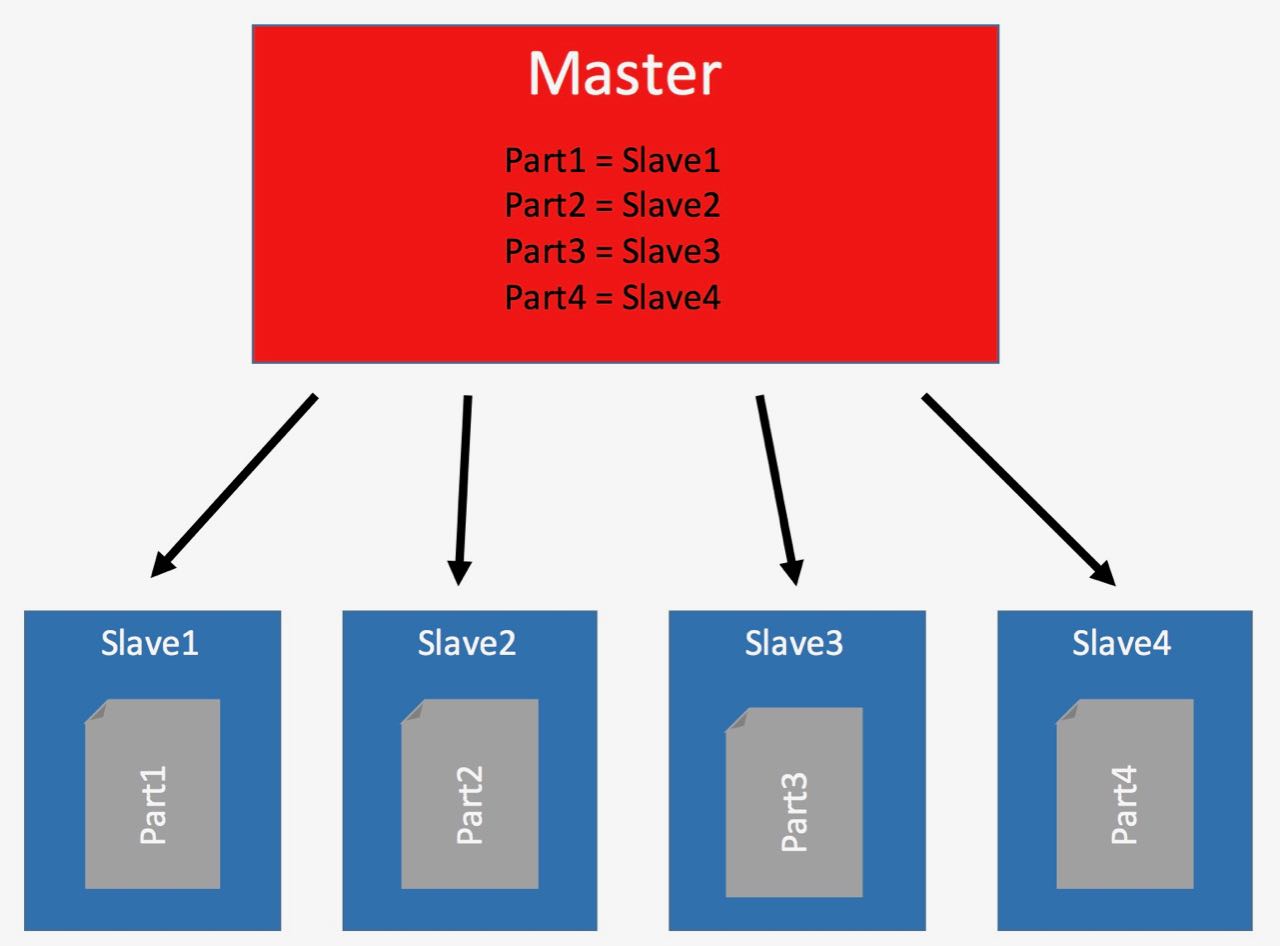
This gives you superior fault tolerance. If one server goes down, then your data stays available on a different server.
Another great thing about HDFS is, that there is no limit how big the files can be. You can have server log files that are terabytes big.
How can files get so big? HDFS allows you to append data to files. Therefore, you can continuously dump data into a single file without worries.
HDFS physically stores files different then a normal file system. It splits the file into blocks.
These blocks are then distributed and replicated on the Hadoop cluster. The splitting happens automatically.

In the configuration you can define how big the blocks should be. 128 megabyte or 1 gigabyte?
No problem at all.
This mechanic of splitting a large file in blocks and distributing them over the servers is great for processing. See the MapReduce section for an example.
Document Store MongoDB#
| Podcast Episode: #093 What is MongoDB |
|---|
| What is the difference between SQL and NoSQL? In this episode I show you on the example of HBase how a key/value store works. |
| Watch on YouTube |
Links:
What is MongoDB:
https://www.guru99.com/what-is-mongodb.html#4
Or directly from MongoDB.com:
https://www.mongodb.com/what-is-mongodb
Storage in BSON files:
https://en.wikipedia.org/wiki/BSON
Hello World in MongoDB:
https://www.mkyong.com/mongodb/mongodb-hello-world-example
Real-Time Analytics on MongoDB Data in Power BI:
https://dzone.com/articles/real-time-analytics-on-mongodb-data-in-power-bi
Spark and MongoDB:
https://www.mongodb.com/scale/when-to-use-apache-spark-with-mongodb
MongoDB vs Time Series Database:
Fun article titled why you should never use mongodb:
http://www.sarahmei.com/blog/2013/11/11/why-you-should-never-use-mongodb/
MongoDB vs Cassandra:
https://blog.panoply.io/cassandra-vs-mongodb
Elasticsearch Search Engine and Document Store#
Elasticsearch is not a DB but firstly a search engine that indexes JSON documents.
| Podcast Episode: #095 What is Elasticsearch & Why is It So Popular?
|------------------|
|Elasticsearch is a super popular tool for indexing and searching data. On this stream we check out how it works, architectures and what to use it for. There must be a reason why it is so popular.
| Watch on YouTube
Links:
Great example for architecture with Elasticsearch, Logstash and Kibana:\ https://www.elastic.co/pdf/architecture-best-practices.pdf
Introduction to Elasticsearch in the documentation:\ https://www.elastic.co/guide/en/elasticsearch/reference/current/elasticsearch-intro.html
Working with JSON documents:\ https://www.slideshare.net/openthinklabs/03-elasticsearch-data-in-data-out
JSONs need to be flattened heres how to work with nested objects in the JSON:\ https://www.elastic.co/guide/en/elasticsearch/reference/current/nested.html
Indexing basics:\ https://www.slideshare.net/knoldus/deep-dive-into-elasticsearch
How to do searches with search API:\ https://www.elastic.co/guide/en/elasticsearch/reference/current/search.html
General recommendations when working with Elasticsearch:\ https://www.elastic.co/guide/en/elasticsearch/reference/current/general-recommendations.html
JSON document example and intro to Kibana:\ https://www.slideshare.net/objectrocket/an-intro-to-elasticsearch-and-kibana
How to connect Tableau to Elasticsearch:\ https://www.elastic.co/guide/en/elasticsearch/reference/current/sql-client-apps-tableau.html
Benchmarks how fast Elasticsearch is:\ https://medium.appbase.io/benchmarking-elasticsearch-1-million-writes-per-sec-bf37e7ca8a4c
Elasticsearch vs MongoDB quick overview:\ https://db-engines.com/en/system/Elasticsearch%3BMongoDB
Logstash overview (preprocesses data before insert into Elasticsearch) https://www.elastic.co/products/logstash
X-Pack Security for Elasticsearch:\ https://www.elastic.co/guide/en/elasticsearch/reference/current/security-api.html
Google Trends Grafana vs Kibana:\ https://trends.google.com/trends/explore?geo=US&q=%2Fg%2F11fy132gmf,%2Fg%2F11cknd0blr
Apache Impala#
Kudu#
Apache Druid#
| Podcast Episode: Druid NoSQL DB and Analytics DB Introduction |------------------| |In this video I explain what Druid is and how it works. We look into the architecture of a Druid cluster and check out how Clients access the data. |Watch on YouTube
InfluxDB Time Series Database#
What is time-series data?
https://questdb.io/blog/what-is-time-series-data/
Key concepts:
https://docs.influxdata.com/influxdb/v1.7/concepts/key_concepts/
InfluxDB and Spark Streaming
Building a Streaming application with spark, grafana, chronogram and influx:
Performance Dashboard Spark and InfluxDB:
https://db-blog.web.cern.ch/blog/luca-canali/2019-02-performance-dashboard-apache-spark
Other alternatives for time series databases are: DalmatinerDB, QuestDB, Prometheus, Riak TS, OpenTSDB, KairosDB
MPP Databases (Greenplum)#
Azure Cosmos DB#
https://azure.microsoft.com/en-us/services/cosmos-db/
Azure Table-Storage#
https://azure.microsoft.com/en-us/services/storage/tables/
NoSQL Data warehouse#
Hive Warehouse#
Impala#
Visualize#
Android & IOS#
How to design APIs for mobile apps#
How to use Webservers to display content#
Dashboards#
Grafana#
Kibana#
Tomcat#
Jetty#
NodeRED#
React#
Business Intelligence Tools#
Tableau#
PowerBI#
Quliksense#
Identity & Device Management#
What is a digital twin?#
Active Directory#
Machine Learning#
| Podcast Episode: Machine Learning In Production
|------------------|
|Doing machine learning in production is very different than for proof of concepts or in education. One of the hardest parts is keeping models updated.
| Listen on Anchor
How to do Machine Learning in production#
Machine learning in production is using stream and batch processing. In the batch processing layer you are creating the models, because you have all the data available for training.
In the stream in processing layer you are using the created models, you are applying them to new data.
The idea that you need to incorporate is that it is a constant cycle. Training, applying, re-training, pushing into production and applying.
What you don't want to do is doing this manually. You need to figure out a process of automatic retraining and automatic pushing to into production of models.
In the retraining phase the system automatically evaluates the training. If the model no longer fits it works as long as it needs to create a good model.
After the evaluation of the model is complete and it's good, the model gets pushed into production. Into the stream processing.
Why machine learning in production is harder then you think#
How to automate machine learning is something that drives me day in and day out.
What you do in development or education is, that you create a model and fit it to the data. Then that model is basically done forever.
Where I'm coming from, the IoT world, the problem is that machines are very different. They behave very different and experience wear.
Models Do Not Work Forever#
Machines have certain processes that decrease the actual health of the machine. Machine wear is a huge issue. Models that that are built on top of a good machine don't work forever.
When the Machine wears out, the models need to be adjusted. They need to be maintained, retrained.
Where The Platforms That Support This?#
Automatic re-training and re-deploying is a very big issue, a very big problem for a lot of companies. Because most existing platforms don't have this capability (I actually haven't seen one until now).
Look at AWS machine learning for instance. The process is: build, train, tune deploy. Where's the loop of retraining?
You can create models and then use them in production. But this loop is almost nowhere to be seen.
It is a very big issue that needs to be solved. If you want to do machine learning in production you can start with manual interaction of the training, but at some point you need to automate everything.
Training Parameter Management#
To train a model you are manipulating input parameters of the models.
Take deep learning for instance.
To train you are manipulating for instance:
- How many layers do you use. - The depth of the layers, which means how many neurons you have in a layer. - What activation function you use, how long are you training and so on.
You also need to keep track of what data you used to train which model.
All those parameters need to be manipulated automatically, models trained and tested.
To do all that, you basically need a database that keeps track of those variables.
How to automate this, for me, is like the big secret. I am still working on figuring it out.
What's Your Solution?#
Did you already have the problem of automatic re-training and deploying of models as well?
Were you able to use a cloud platform like Google, AWS or Azure?
It would be really awesome if you share your experience :)
How to convince people machine learning works#
Many people still are not convinced that machine learning works reliably. But they want analytics insight and most of the time machine learning is the way to go.
This means, when you are working with customers you need to do a lot of convincing. Especially if they are not into machine learning themselves.
But it's actually quite easy.
No Rules, No Physical Models#
Many people are still under the impression that analytics only works when it's based on physics. When there are strict mathematical rules to a problem.
Especially in engineering heavy countries like Germany this is the norm:
"Sere has to be a Rule for Everysing!" (imagine a German accent). When you're engineering you are calculating stuff based on physics and not based on data. If you are constructing an airplane wing, you better make sure to use calculations so it doesn't fall off.
And that's totally fine.
Keep doing that!
Machine learning has been around for decades. It didn't quite work as good as people hoped. We have to admit that. But there is this preconception that it still doesn't work.
Which is not true: Machine learning works.
Somehow you need to convince people that it is a viable approach. That learning from data to make predictions is working perfectly.
You Have The Data. USE IT!#
As a data scientist you have one ace up your sleeve, it's the obvious one:
It's the data and it's statistics.
You can use that data and those statistics to counter peoples preconceptions. It's very powerful if someone says: "This doesn't work"
You bring the data. You show the statistics and you show that it works reliably.
A lot of discussions end there.
Data doesn't lie. You can't fight data. The data is always right.
Data is Stronger Than Opinions#
This is also why I believe that autonomous driving will come quicker than many of us think. Because a lot of people say, they are not safe. That you cannot rely on those cars.
The thing is: When you have the data you can do the statistics.
You can show people that autonomous driving really works reliably. You will see, the question of \"Is this allowed or is this not allowed?\" will be gone quicker than you think.
Because government agencies can start testing the algorithms based on predefined scenarios. They can run benchmarks and score the cars performance.
All those opinions, if it works, or if it doesn't work, they will be gone.
The motor agency has the statistics. The stats show people how good cars work.
Companies like Tesla, they have it very easy. Because the data is already there.
They just need to show us that the algorithms work. The end.
AWS Sagemaker#
Train and apply models online with Sagemaker
Link to the OLX Slideshare with pros, cons and how to use Sagemaker: https://www.slideshare.net/mobile/AlexeyGrigorev/image-models-infrastructure-at-olx